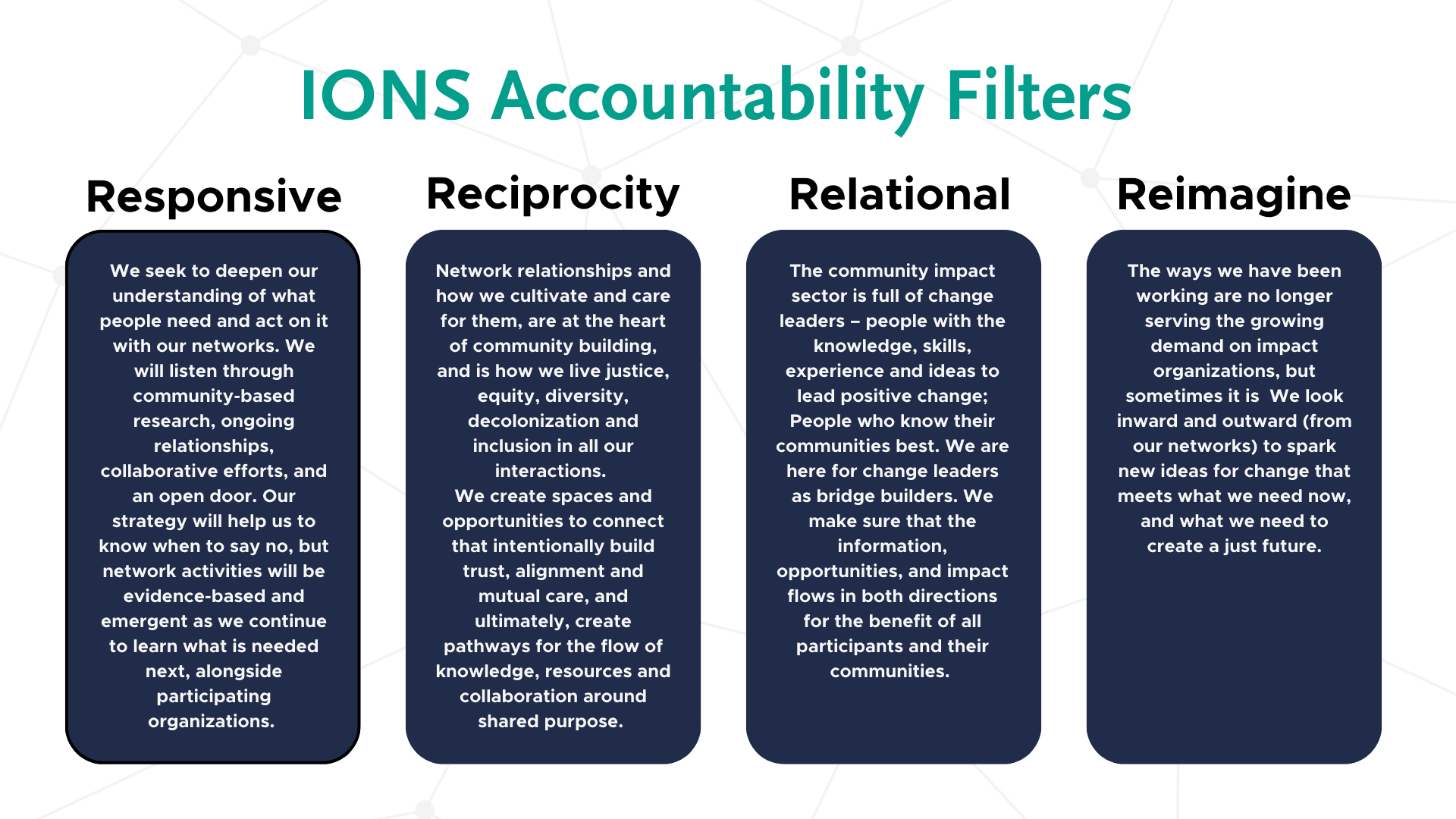
Alexandra Theroux
Operations Director

Priya Andrade
Learning Content Developer
Alexandra and Priya came together to highlight their perspectives in the Onboarding process and how they are making adjustments to the way that IONS supports new team members joining the organization. They are both visual artists and passionate about learning and teaching. This blog is the result of conversations, reflections, and collaboration between them.
Starting a new job is much like starting at a new school – “first day jitters”, wondering what to wear, what to bring for lunch, how to navigate a new commute (or your remote workspace), and how to introduce yourself to new colleagues. Anyone who has entered a new space – whether that’s a class, community group, or a sports team – can probably relate with the combined sense of possibility and anticipation that comes with a new job – “is this a place I can belong?”.
From an organization’s side of that equation, there is similar excitement. The existing team considers questions like “is this new person going to gel with our team?”, “how will they impact the culture?”, and “how can we make them feel welcome?”. We then try to capture this information about the organization and role in an orientation process so new employees can “hit the ground running.”
The Difference Between Onboarding and Orientation
“Did you have a good commute? Great! Here’s the employee handbook, paperwork to fill out, and your training for ‘X’ and ‘Y’ are at this time. Let me know if you have any questions!”
Sound familiar? That’s orientation. Essentially, it’s the info-dump of how this organization does things and the rule book of what we expect you to know and do. Many of us don’t know the difference between orientation and onboarding until we see it. Onboarding centers a more holistic experience to build relationships with the organization, the work, and the people who drive it.
Onboarding requires a lot of time, effort, and intention. Organizations typically recruit because there is a skills gap, heavy workloads, or during periods of crisis management – which likely means strain on the current team as they try to manage additional tasks on top of their own responsibilities. With that sense of urgency, prioritizing a slower more intentional onboarding process can be challenging. How do you balance the time needed to support a new hire while alleviating workloads of current team members?
There’s no easy answer to this question, and the approach depends on your organization’s values, external pressures, and the capacity of your team. IONS has been trying to find this balance for years. Our onboarding has looked different for almost everyone on our team. Throughout time it has been emails on the first day, large binders of information prior to the start date, a day or week of focused meetings, to most recently – a full six-month process. What’s interesting about these different iterations is that none of them have been “perfect”. And it will probably never be.
Accountability in the Onboarding Process
IONS is a learning organization, and with that comes a lot of change as we evolve and adjust our processes and ways of working to respond to data and feedback in real-time. Over the past three years, our organization’s formal onboarding practices have been revised, overhauled, and improved in so many ways but we continue to look for the balance.
After reflecting on our most recent onboarding round, we decided to review our practices using the “Four R’s”. Inspired by the Mi’kmaw concept of “Netukulimk”, the “Four R’s” – Responsive, Relational, Reciprocity, and Reimagine – help guide decisions related to our work and each other and stay accountable to IONS’ values.

1. Be Responsive
“We seek to deepen our understanding of what people need and act on it with our networks.”
Onboarding into an emergent system demands adaptation. It involves staying agile, and continuously learning and unlearning. In our community engagement work, we use the tenets of human centred design thinking: Empathy, Iteration, Collaboration, Focusing on user experiences, and Prototyping and Testing.
Could onboarding include this mindset to better respond to the needs and experiences of new hires? Could we rethink the “steep learning curve” for new hires and carry some of the load? Here’s a few things we have tried.
-
- Regular check ins. IONS’ internal operating rhythm includes a weekly full team meeting, departmental meetings, and 1:1 check ins between directors and individual staff. These meetings prioritize human centred thinking to design empathetic spaces and to collaborate. Additionally, regular check-ins provide motivation, guidance, goal alignment, early-stage issue intervention, accountability, and ongoing feedback.
- Tangible resources to support learning. To better pace the initial “info-dump” for individuals, we’re creating an internal online “course” with activities to help new hires flow through organizational content and initial tasks (i.e., branding and key messages, creating your email signature, digital systems orientation, etc.). This allows for practical learning without pressure of formal projects. It also frees up time from team members who would typically be delivering the sessions live and allows them to tailor content to the role and support in other ways.
- Creating a Clear Workplan for the first 3-6 months. Challenging the “hit the ground running” mindset – a mix of learning and role related deliverables built into the process helps a new hire get a sense of their role, practice the work they will ultimately be responsible for, and provides an understanding of how their work supports the team.
So how can the onboarding process and organizational systems reveal individual responsiveness and encourage a collaborative mindset? Through relationships.
2. Be Relational
“We create spaces and opportunities to connect that intentionally build trust, alignment and mutual care.”
An organization is the people. At IONS, we embrace a few philosophies, including Ubuntu. It emphasizes the interconnectedness of humanity and that we exist and define ourselves in relation to others. So how do we build relationships while balancing the work that needs to be done?
-
- Individual Working/ Learning Styles. Before jumping into projects, we spend time discussing how we want to work together and communicate. Personality or work style activities create an opportunity for rich dialogue to better understand individual thought processing, personal values, professional pain points, and motivations. At IONS we’ve leaned into the “Thinking Talents” exercise to provide shared language around our gifts.
- Internal “team profiles”. These provide a space for team members to share additional information around how they work (i.e. “Things I need to be my best self at work”, “You can tell that I’m stressed when…”, “I prefer to receive feedback…”, etc.). At IONS we’ve create a digital white board to map out these profiles in one place for the team to reference. This process allows individual and foundational needs around working and collaboration to emerge.
Since IONS is still relatively small, we prioritize having new hires meet with team members one-on-one within the first 2 months to establish a foundation for a relationship and to understand the different roles and cross-teaming throughout the organization. A big part of making a new hire feel welcome is ensuring they feel like they are a part of the collective.
3. Be Reciprocal
“We make sure that information, opportunities, and impact flows in both directions.”
Another practice we uplift and are practicing at IONS is reciprocity. In the context of onboarding, we are flipping the traditional model of orientation which is transactional and instead creating space for the new employees’ leadership and experience.
-
- Benefits Start from Day One. Reciprocity is about recognizing a new hire’s expertise and giving them the tools to care for themselves. Recently we’ve changed our policies to ensure that access to our health coverage begins on the first day. Read our blog about why we’ve done this (and how you could try)!
- Inviting Feedback. Before the new team member starts, we ensure that we have protected time to get feedback and adjust or adapt our methods as we go. In regular check-ins and a formal debrief, we create space to share “radical candor” with each other – this where we might identify changes that may need to occur.
- Establishing clear expectations from the beginning. One of the bigger challenges we experienced recently was the lack of clear expectations for the process. Ensuring that we go over the roles, timeline, and expectations explicitly early on helps provide a common baseline reference as we move through the process.
- Diving Into the Deep End. Many of our team members have a story of being part of a deep culture conversation within their first days or weeks at IONS. Where an organization might have newer folks opt out of these potentially tricky discussions if it’s related to past events, we invite new folks into it. We recognize that decisions could be made that impact our culture, and though someone may not have had a hand in past events, they should be able to participate in informing how we work together in the future.
Reciprocity in Onboarding considers how we want someone to feel when they join the team and find their place, autonomy in the process, and is aligned with our values of Abundance, Courage, and Trust.
4. We Reimagine
“We look inward and outward to spark new ideas for change that meets what we need now, and what we need to create a just future.”
The Onboarding process won’t succeed without prioritizing time for relationships and adaptation. Trust is one of our core values at IONS and one we’re recognizing is a cornerstone of our ability to reimagine and our organizational resilience to change. Through all our iterations, we are reminded that it requires time and no approach can ever be one-size-fits-all. Some of the ways we’ve tried to reimagine Onboarding is as a process that is inclusive and responsive to the needs of individuals and the existing team; a process that requires dedicated space; a process that is open to new ideas; and one that relies heavily on trust building to navigate change.
We’ve realized that Onboarding is less about the specific job or task training, organizational learning, and tangible checklists – and more about providing space and opportunities to build trust within the team. By applying the Four Rs of our strategy, we’re creating the conditions for trust to flourish.
Celebrating Emergence
At IONS we “joke” (more like laugh so we don’t cry) about how we’re in a constant state of change which can leave staff, especially new hires, feeling uncertain or anxious. The reality is that our sector – and the world – is always changing. So, what we can do is build more resilience and reframe “change” as “emergence.” This helps us see change as a way to do things differently or to make an impact in a new, exciting way.
Throughout recruitment, we emphasize the organizational dynamic and share the challenges and opportunities of emergence. Helping new staff adopt this mindset is important in understanding our team culture, and we admittedly don’t always get it right. But we hope that by prioritizing relationality and reciprocity, we are inviting new team members into the rewarding, energizing experience of collective growth at IONS – the one they envisioned when they hit the submit application button.
Additional Resources:
- IONS Template: Understanding Team Working Styles
- Resource: Creating Your Own Group Agreements
- Resource: Example Check-in Discussion Guide
- Resource: How to Build a new Employee Onboarding Process
Written by:

Alexandra Theroux (she/her)
Operations Director
Alexandra supports the sector’s capacity to create meaningful impact and contributes to IONS’ work by seeking out innovative processes, policies, and digital systems. She uses her creativity to find new ways of strengthening organizations’ operations so they can focus on supporting communities.

Priya Andrade (she/her)
Engagement Lead
Priya finds and develops e-learning solutions for capacity building within the Community Impact Sector. She supports IONS’ work by channeling her love of knowleding sharing and her education in anti-oppression techniques. Her power lies in creation at the nexus of community relationships, technology, creativity, and learning.
Liked this post? Please share!

0 Comments